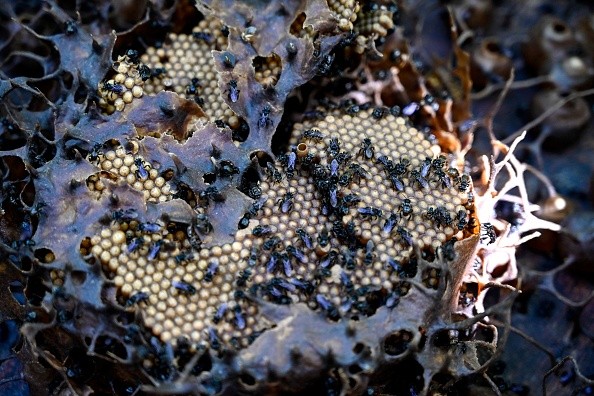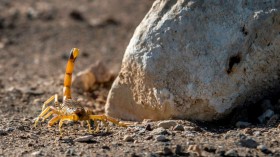Despite widespread recognition of bumble bee mimicry, distinct North American mimicry rings have yet to be defined, owing in part to the prevalence of intermediate and imperfect mimics in this region.
To categorize mimicry rings among North American bumble bees, scientists use a generalization approach based on human perception.
They then visually test for geographic concordance among similarly colored species by mapping species distributions on North American ecoregions.
Scientists use human perception to define bumble bee mimicry
 (Photo : CHAIDEER MAHYUDDIN/AFP via Getty Images)
(Photo : CHAIDEER MAHYUDDIN/AFP via Getty Images)

Unlike humans, animals in search of food do not have the luxury of deliberative decision-making or consulting Yelp.
It's a split-second decision of what will satisfy my past-due caloric survival need while not harming or killing me, as per ScienceDaily.
When a bird spots a bumble bee, it must decide quickly whether it is edible or will sting it.
It doesn't stop to count stripes, comparing colors, or analyzing DNA, according to Joseph Wilson, associate professor of biology at Utah State University Tooele.
Wilson, along with Sussy Alvarez of the University of Utah, Aaron Pan of Texas Tech University, and independent scientist Olivia Messinger Carril, published findings in Nature's open-access journal Scientific Reports on Oct. 20, about the researchers' generalization approach using human perception to categorize mimicry rings among North American bumble bees.
Mimicry, a form of defense in which one animal mimics another of a different species in appearance, actions, or sound, was discovered by scientists in the late nineteenth century.
Batesian mimicry, which includes harmless copycats of brightly colored poisonous butterflies and frogs that fool predators into leaving them alone, is one of the most common examples.
Müllerian mimicry is another type, in which multiple harmful species, including bumble bees, look-alike as a similar warning to predators.
Despite widespread recognition of bumble bee mimicry, Wilson claimed that distinct North American mimicry rings have yet to be defined.
"To identify mimicry rings, scientists typically use mathematical models of frequency-dependent selection with sophisticated machine-learning algorithms being used more recently," he said.
Machine learning is an effective analytical tool, but a predator does not always think like a machine, according to Wilson.
Machine learning may overestimate species differences, whereas predators, including humans, seek out similarities. Human perception is, in fact, very similar to that of vertebrate predators.
Also Read: Female Hummingbirds Look Like Males in Deceptive Mimicry, Anti-Predator Defense
The Arts Of Deception
Batesian Imitation
Batesian mimicry is named after Henry Walter Bates, a British scientist who studied Amazonian butterfly mimicry in the mid- and late-nineteenth century.
Batesian mimicry refers to two or more species that appear to be identical, but only one is armed with spines, stingers, or toxic chemistry, while its apparent double lacks these characteristics, as per Mongabay.
The second species has no defense other than a resemblance to the unpalatable species, which the predator associates with a specific appearance and a bad experience.
Several species of butterflies that mimic the toxic Heliconid butterflies are examples of Batesian mimicry.
The non-toxic Papilio memmon of Indonesia is another fascinating butterfly mimic.
Muellerian imitation
Muellerian mimicry is named after Fritz Mueller, a German zoologist who spent three decades in the Amazon after Bates.
This type of mimicry refers to two unpalatable species that are exact replicas of each other, complete with prominent warning coloration (also known as aposematic coloration).
Because the predator will recognize the coloration of an unpalatable group after a few bad experiences, all mimics benefit from the coloration.
Because several species resemble the predator, the loss of life will be distributed among them, reducing the impact on each individual species.
Poison arrow frogs from South America and Mantella frogs from Madagascar are two species that stand out due to their bright colors against black markings and toxic composition.
Mimicry of Oneself
Self-mimicry is a misleading term for animals in which one body part mimics another in order to increase survival during an attack or to make predators appear innocuous.
Numerous moth, butterfly, and freshwater fish species, for example, have "eye-spots:" large dark markings that, when flashed, can startle a predator and give the prey extra seconds to escape.
"Eye-spots" also aid prey in evading predators by providing predators with a false target.
An attack to the outer part of a butterfly's wing has a better chance of surviving than an attack to the head.
Related article: Microchip Mimicry: a New Means of Cancer Study
© 2024 NatureWorldNews.com All rights reserved. Do not reproduce without permission.

![Bison Herd Consisting of 170 Reintroduced Individuals in Romania Could Store Carbon Emissions Equivalent to 43,000 Cars [Study]](https://1471793142.rsc.cdn77.org/data/thumbs/full/70533/280/157/50/40/bison-herd-consisting-of-170-reintroduced-individuals-in-romania-could-store-carbon-emissions-equivalent-to-43-000-cars-study.jpg)



